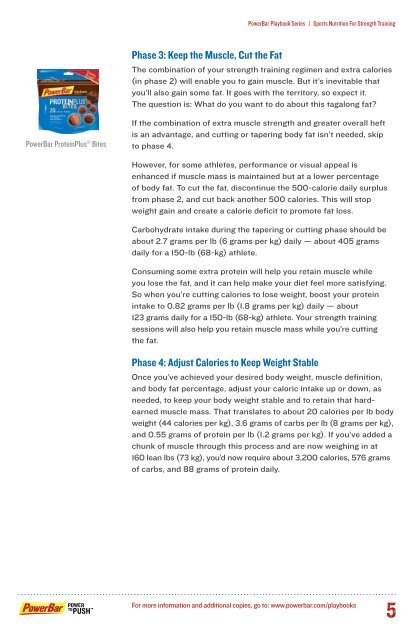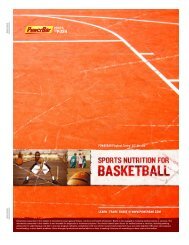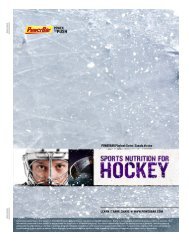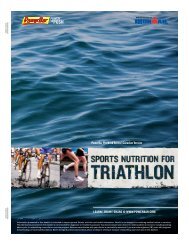sports nutrition for strength training - PowerBar.Com
sports nutrition for strength training - PowerBar.Com
sports nutrition for strength training - PowerBar.Com
Create successful ePaper yourself
Turn your PDF publications into a flip-book with our unique Google optimized e-Paper software.
<strong>PowerBar</strong> Playbook Series | Sports Nutrition For Strength Training<br />
Phase 3: Keep the Muscle, Cut the Fat<br />
The combination of your <strong>strength</strong> <strong>training</strong> regimen and extra calories<br />
(in phase 2) will enable you to gain muscle. But it’s inevitable that<br />
you’ll also gain some fat. It goes with the territory, so expect it.<br />
The question is: What do you want to do about this tagalong fat?<br />
<strong>PowerBar</strong> ProteinPlus ® Bites<br />
If the combination of extra muscle <strong>strength</strong> and greater overall heft<br />
is an advantage, and cutting or tapering body fat isn’t needed, skip<br />
to phase 4.<br />
However, <strong>for</strong> some athletes, per<strong>for</strong>mance or visual appeal is<br />
enhanced if muscle mass is maintained but at a lower percentage<br />
of body fat. To cut the fat, discontinue the 500-calorie daily surplus<br />
from phase 2, and cut back another 500 calories. This will stop<br />
weight gain and create a calorie deficit to promote fat loss.<br />
Carbohydrate intake during the tapering or cutting phase should be<br />
about 2.7 grams per lb (6 grams per kg) daily — about 405 grams<br />
daily <strong>for</strong> a 150-lb (68-kg) athlete.<br />
Consuming some extra protein will help you retain muscle while<br />
you lose the fat, and it can help make your diet feel more satisfying.<br />
So when you’re cutting calories to lose weight, boost your protein<br />
intake to 0.82 grams per lb (1.8 grams per kg) daily — about<br />
123 grams daily <strong>for</strong> a 150-lb (68-kg) athlete. Your <strong>strength</strong> <strong>training</strong><br />
sessions will also help you retain muscle mass while you’re cutting<br />
the fat.<br />
Phase 4: Adjust Calories to Keep Weight Stable<br />
Once you’ve achieved your desired body weight, muscle definition,<br />
and body fat percentage, adjust your caloric intake up or down, as<br />
needed, to keep your body weight stable and to retain that hardearned<br />
muscle mass. That translates to about 20 calories per lb body<br />
weight (44 calories per kg), 3.6 grams of carbs per lb (8 grams per kg),<br />
and 0.55 grams of protein per lb (1.2 grams per kg). If you’ve added a<br />
chunk of muscle through this process and are now weighing in at<br />
160 lean lbs (73 kg), you’d now require about 3,200 calories, 576 grams<br />
of carbs, and 88 grams of protein daily.<br />
For more in<strong>for</strong>mation and additional copies, go to: www.powerbar.com/playbooks<br />
5







